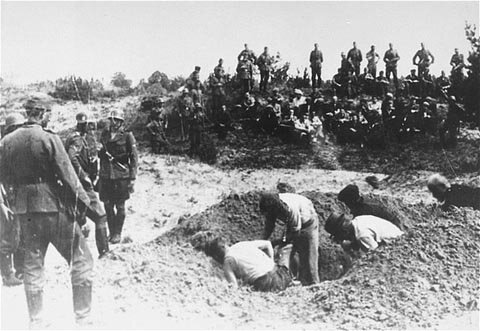|
Holocaust Education & Archive Research Team |
www.HolocaustResearchProject.org |
|
Einsatzgrϋppen
Einsatz Group A Einsatz Group B Einsatz Group C Einsatz Group D Babi Yar Witness Accounts Articles Einsatz Leaders Einsatzgruppen Operational Situational Reports [ OSR's #8 - #195 ]
|
||||
|
Otto Ohlendorf
Otto Ohlendorf was the Head of Amt lll of the Reich Main Security Office during the Second World War and organiser of mass murders in the Southern Ukraine in 1941 and 1942.
He was born in Hoheneggelsen on 4 February 1907, the son of a peasant farmer. Educated at a humanistic Gymnasium in Hildesheim, he later studied law at the Universities of Leipzig and Gottingen, graduating in July 1933.
In October 1933 he became Assistant to Professor Jessen at the Institute of World Economy at the University of Kiel. He specialised in the study of National Socialism and Italian fascism – he was subsequently the only top SS leader to be familiar with the syndicalism elements and organisational structure of fascist Italy.
In January 1935 Ohlendorf became departmental head at the Institute of Applied Economic Science before entering the SD and working under Professor Reinhard Hohn in the following year. Parallel to his promising academic career, the intelligent, idealistic Ohlendorf had been active in the National Socialist Students’ League in Kiel and Gottingen as well as teaching at the Party school in Berlin in 1935.
He had been one of the first members of the newly constituted NSDAP back in 1925, when he was only eighteen years old, entering the SS a year later and also fulfilling various SA duties in his home district. The highly educated lawyer and economist was promoted to Major in the SD in 1938 and the following year became head of Amt lll of the RSHA, a position he retained until the end of the Second World War.
Ohlendorf’s security services provided intelligence information of a unique kind in the Third Reich, prying into the lives and thoughts of ordinary citizens in Nazi Germany and acting as a secret and relatively candid recorder of “public opinion,” for the benefit of the leadership.
Although Ohlendorf’s research workers were secret police agents, his activities were much disliked by Himmler, who characterised the SD chief as an ”unbearable Prussian, without humour, defeatist and anti-militarist and a professional debunker.”
When Himmler organised his special extermination units for service in Russia, Major General Ohlendorf’s bureaucratic career was interrupted - from June 1941 to June 1942 he was made Commander of Einsatzgruppen D, which operated at the extreme southern end of the eastern front.
Attached to the Eleventh Army, the academically trained bloodhound and his units in the Ukraine were responsible for the execution of 90,000 men, women and children, mostly Jews.
In contrast to some other group commanders, Ohlendorf ordered that several of his men should shoot the victims at the same time “to avoid direct personal responsibility”, as he claimed later at Nuremburg War Crimes trial, it was “psychologically, an immense burden to bear” for the executioners.
As for the mass murder of Jews in Nikolaiev, Kherson, Podolia and the Crimea which his units carried out, Ohlendorf later defended it from the dock as a historically necessary task to secure “lebensraum” for the German Reich in the East. Recalling precedents such as the murder of gypsies in the Thirty Years War and even the Biblical Israelites extirpation of their enemies, Ohlendorf asserted that history would regard his firing squads as no worse than the “push-button killers” who dropped the atom bomb on Japan.
Having completed his stint as an organiser of mass murders, Ohlendorf returned quietly to the Reich Ministry of Economics, where in November 1943 he became the manager of a committee on export trade and a delegate to the Central Planning Board.
Promoted to SS Lieutenant- General in November 1944, Ohlendorf still retained his post as head of Amt lll in the RSHA, he even figured as a “liberal” member in Himmler’s entourage, suggesting at the end of the war that the Reichsfuhrer – SS surrender himself to the Allies in order to vindicate the SS against the “calumnies” of its enemies.
Himmler’s right- hand man, Walter Schellenberg, seriously proposed Ohlendorf as the member of a cabinet list which would be presentable to the Allies. His judges at Nuremburg took a very different view of the attractive, youthful- looking secret service chief, describing him as a Jekyll and Hyde character, some of whose acts defied belief.
During the trial against Einsatzgruppen leaders, Ohlendorf was the chief defendant, and was also a key witness in the prosecution of many other indicted war criminals.
Ohlendorf's frank, apparently reliable testimony was attributed to his distaste for the corruption that was rampant in Nazi Germany and a stubborn commitment to duty. He expressed no remorse for his actions and famously, would seem to have been more concerned about the moral strain on those carrying out the executions than those actually being executed.
Ohlendorf was sentenced to death in April 1948, he spent three and a half years in detention before being hanged, along with three other Einsatzgruppen commanders, in Landsberg prison on 8 June 1951.
Sources:
Who’s Who in Nazi Germany by Robert S Wistrich published by Routledge, London and New York 1995. The Final Solution by G. Reitlinger, published by Vallentine and Mitchell 1953. USHMM NARA PRO
Copyright: CW & CL H.E.A.R.T 2007
|










